A Study on the Predictive Maintenance Algorithms Considering Load Characteristics of PMSMs to Drive EGR Blowers for Smart Ships
Abstract
:1. Introduction
2. Performance Analysis of the EGR Blower System
2.1. Performance Analysis of the EGR Blower
2.2. Performance Analysis of the PMSM
3. Predictive Maintenance Algorithm of the PMSM
4. Verification
4.1. Simulation Results
4.2. Experimental Results
5. Conclusions
Author Contributions
Funding
Institutional Review Board Statement
Informed Consent Statement
Data Availability Statement
Conflicts of Interest
References
- Hiraoka, N.; Miyanagi, A.; Kuroda, K.; Ito, K.; Nakagawa, T.; Ueda, T. The World’s First Onboard Verification Test of UE Engine with Low Pressure EGR complied with IMO’s NOx Tier III Regulations. Mitsubishi Heavy Ind. Tech. Rev. 2016, 53, 40. [Google Scholar]
- Stoumpos, S.; Theotokatos, G. Multiobjective optimisation of a marine dual fuel engine equipped with exhaust gas recirculation and air bypass systems. Energies 2020, 13, 5021. [Google Scholar] [CrossRef]
- Lao, C.T.; Akroyd, J.; Eaves, N.; Smith, A.; Morgan, N.; Nurkowski, D.; Bhave, A.; Kraft, M. Investigation of the impact of the configuration of exhaust after-treatment system for diesel engines. Appl. Energy 2020, 267, 114844. [Google Scholar] [CrossRef]
- Forzatti, P.; Lietti, L.; Nova, I.; Tronconi, E. Diesel NOx aftertreatment catalytic technologies: Analogies in LNT and SCR catalytic chemistry. Catal. Today 2010, 151, 202–211. [Google Scholar] [CrossRef]
- Koop, J.; Deutschmann, O. Detailed surface reaction mechanism for Pt-catalyzed abatement of automotive exhaust gases. Appl. Catal. B Environ. 2009, 91, 47–58. [Google Scholar] [CrossRef]
- Gurupatham, A.; He, Y. Architecture design and analysis of diesel engine exhaust aftertreatment system and comparative study with close-coupled DOC-DPF System. SAE Int. J. Fuels Lubr. 2009, 1, 1387–1396. [Google Scholar] [CrossRef]
- Wei, L.; Yan, F.; Hu, J.; Xi, G.; Liu, B.; Zeng, J. NOx conversion efficiency optimization based on NSGA-II and state-feedback nonlinear model predictive control of selective catalytic reduction system in diesel engine. Appl. Energy 2017, 206, 959–971. [Google Scholar] [CrossRef]
- Cho, C.P.; Pyo, Y.D.; Jang, J.Y.; Kim, G.C.; Shin, Y.J. NOx reduction and N2O emissions in a diesel engine exhaust using Fe-zeolite and vanadium based SCR catalysts. Appl. Therm. Eng. 2017, 110, 18–24. [Google Scholar] [CrossRef]
- Kim, J.H.; Kim, M.Y.; Kim, H.G. NO2-assisted soot regeneration behavior in a diesel particulate filter with heavy-duty diesel exhaust gases. Numer. Heat Transf. Part A Appl. 2010, 58, 725–739. [Google Scholar] [CrossRef]
- Pakarinen, R. IMO Tier III and Beyond. Available online: https://www.wartsila.com/twentyfour7/environment/imo-tier-iii-and-beyond (accessed on 17 June 2019).
- Rudrabhate, S.D.; Chaitanya, S.V. Comparison between EGR & SCR Technologies. In Proceedings of the International Conference on Ideas, Impact and Innovation in Mechanical Engineering (ICIIIME), Pune, India, 1–2 June 2017; pp. 856–861. [Google Scholar]
- Gautier, P.; Albrecht, A.; Chasse, A.; Moulin, P.; Pagot, A.; Fontvieille, L.; Issartel, D. A Simulation Study of the Impact of LP EGR on a Two-Stage Turbocharged Diesel Engine. Oil Gas Sci. Technol. Rev. IFP 2009, 64, 361–379. [Google Scholar] [CrossRef]
- Zamboni, G.; Capobianco, M. Influence of High and Low Pressure Egr and Vgt Control on in-Cylinder Pressure Diagrams and Rate of Heat Release in an Automotive Turbocharged Diesel Engine. Appl. Therm. Eng. 2013, 51, 586–596. [Google Scholar] [CrossRef]
- Beatrice, C.; Rispoli, N.; Di Blasio, G.; Patrianakos, G.; Kostoglou, M.; Konstandopoulos, A.; Imren, A.; Denbratt, I.; Palacín, R. Emission Reduction Technologies for the Future Low Emission Rail Diesel Engines: EGR vs. SCR; SAE Technical paper; SAE International: Warrendale, PA, USA, 2013. [Google Scholar]
- Buenaventura, F.C.; Witrant, E.; Talon, V.; Dugard, L. Air Fraction and EGR Proportion Control for Dual Loop EGR Diesel Engines. Ing. Univ. 2015, 19, 115. [Google Scholar]
- Yasin, M.H.M.; Mamat, R.; Yusop, A.F.; Idris, D.M.N.D.; Yusaf, T.; Rasul, M.; Najafi, G. Study of a diesel engine performance with exhaust gas recirculation (EGR) system fuelled with palm biodiesel. Energy Procedia 2017, 110, 26–31. [Google Scholar] [CrossRef] [Green Version]
- Maiboom, A.; Tauzia, X.; Shah, S.R.; Hétet, J.F. Experimental Study of an LP EGR System on an Automotive Diesel Engine, compared to HP EGR with respect to PM and NOx Emissions and Specific Fuel Consumption. SAE Int. J. Engines 2010, 2, 597–610. [Google Scholar] [CrossRef]
- Chao, Y.; Lu, H.; Hu, Z.; Deng, J.; Wu, Z.; Li, L.; Yuan, S. Comparison of Fuel Economy Improvement by High and Low Pressure EGR System on a Downsized Boosted Gasoline Engine; No. 2017-01-0682; SAE International: Warrendale, PA, USA, 2017. [Google Scholar]
- Alegret, G.; Llamas, X.; Vejlgaard-Laursen, M.; Eriksson, L. Modeling of a large marine two-stroke diesel engine with cylinder bypass valve and EGR system. IFAC-PapersOnLine 2015, 48, 273–278. [Google Scholar] [CrossRef]
- Lundqvist, U.; Smedler, G.; Stålhammar, P. A Comparison between Different EGR Systems for HD Diesel Engines and Their Effect on Performance, Fuel Consumption and Emissions; No. 2000-01-0226; SAE International: Warrendale, PA, USA, 2000. [Google Scholar]
- Mossa, M.A.A.; Hairuddin, A.A.; Nuraini, A.A.; Zulkiple, J.; Tobib, H.M. Effects of hot exhaust gas recirculation (EGR) on the emission and performance of a single-cylinder diesel engine. Int. J. Automot. Mech. Eng. 2019, 16, 6660–6674. [Google Scholar] [CrossRef]
- Wang, Z.; Zhou, S.; Feng, Y.; Zhu, Y. Research of NOx reduction on a low-speed two-stroke marine diesel engine by using EGR (exhaust gas recirculation)–CB (cylinder bypass) and EGB (exhaust gas bypass). Int. J. Hydrog. Energy 2017, 42, 19337–19345. [Google Scholar] [CrossRef]
- Kiangala, K.S.; Wang, Z. Initiating predictive maintenance for a conveyor motor in a bottling plant using industry 4.0 concepts. Int. J. Adv. Manuf. Technol. 2018, 97, 3251–3271. [Google Scholar] [CrossRef]
- Lu, B.; Durocher, D.B.; Stemper, P. Predictive maintenance techniques. IEEE Ind. Appl. Mag. 2009, 15, 52–60. [Google Scholar] [CrossRef]
- Toni, K.; Slobodan, M.; Aleksandar, B. Detection of turn to turn faults in stator winding with axial magnetic flux in induction motors. In Proceedings of the IEEE International Electric Machines & Drives Conference, Antalya, Turkey, 3–5 May 2007; pp. 826–829. [Google Scholar]
- Husach, S.; Yatsiuk, R.; Mamchur, D. Induction Motors Condition Monitoring and Lifetime Estimation System. In Proceedings of the IEEE International Conference on Modern Electrical and Energy Systems (MEES), Kremenchuk, Ukraine, 23–25 September 2019; pp. 34–37. [Google Scholar]
- Tshiloz, K.; Smith, A.C.; Mohammed, A.; Djurović, S.; Feehally, T. Real-time insulation lifetime monitoring for motor windings. In Proceedings of the XXII International Conference on Electrical Machines (ICEM), Lausanne, Switzerland, 4–7 September 2016; pp. 2335–2340. [Google Scholar]
- Khowja, M.R.; Turabee, G.; Giangrande, P.; Madonna, V.; Cosma, G.; Vakil, G.; Galea, M. Lifetime estimation of enameled wires under accelerated thermal aging using curve fitting methods. IEEE Access 2021, 9, 18993–19003. [Google Scholar] [CrossRef]
- Huber, W. Standortbestimmung. In Industrie 4.0 in Der Automobilproduktion; Springer: Berlin/Heidelberg, Germany, 2016; pp. 7–21. [Google Scholar]
- Kim, S.A.; Hong, K.P. Analysis and Experimental Verification of a Variable Speed Turbo Air Centrifugal Compressor System for Energy Saving. Energies 2021, 14, 1208. [Google Scholar] [CrossRef]
- Kim, S.A. Improved Modeling of a Multi-Level Inverter for TACS to Reduce Computational Time and Improve Accuracy. Energies 2021, 14, 849. [Google Scholar] [CrossRef]
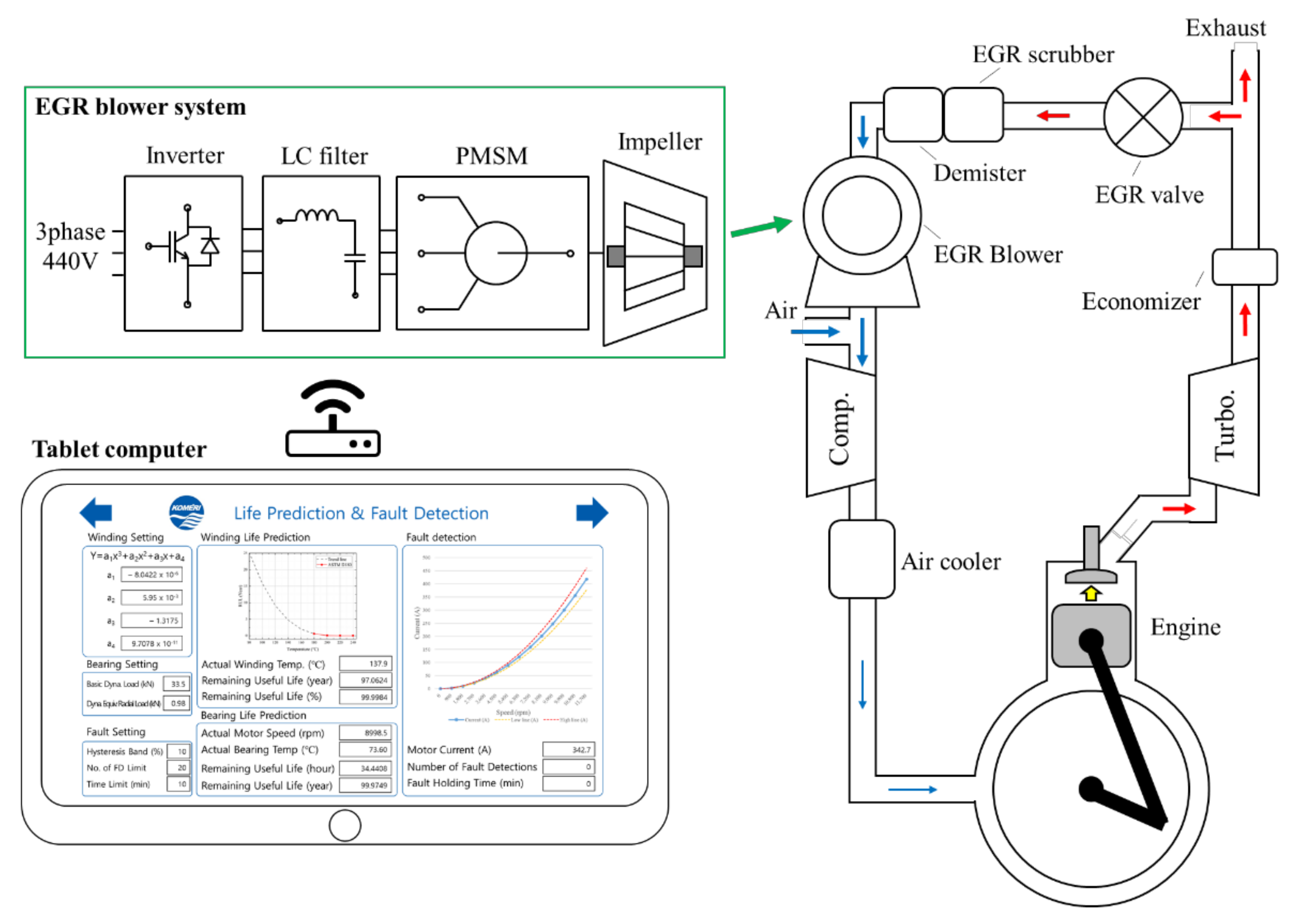
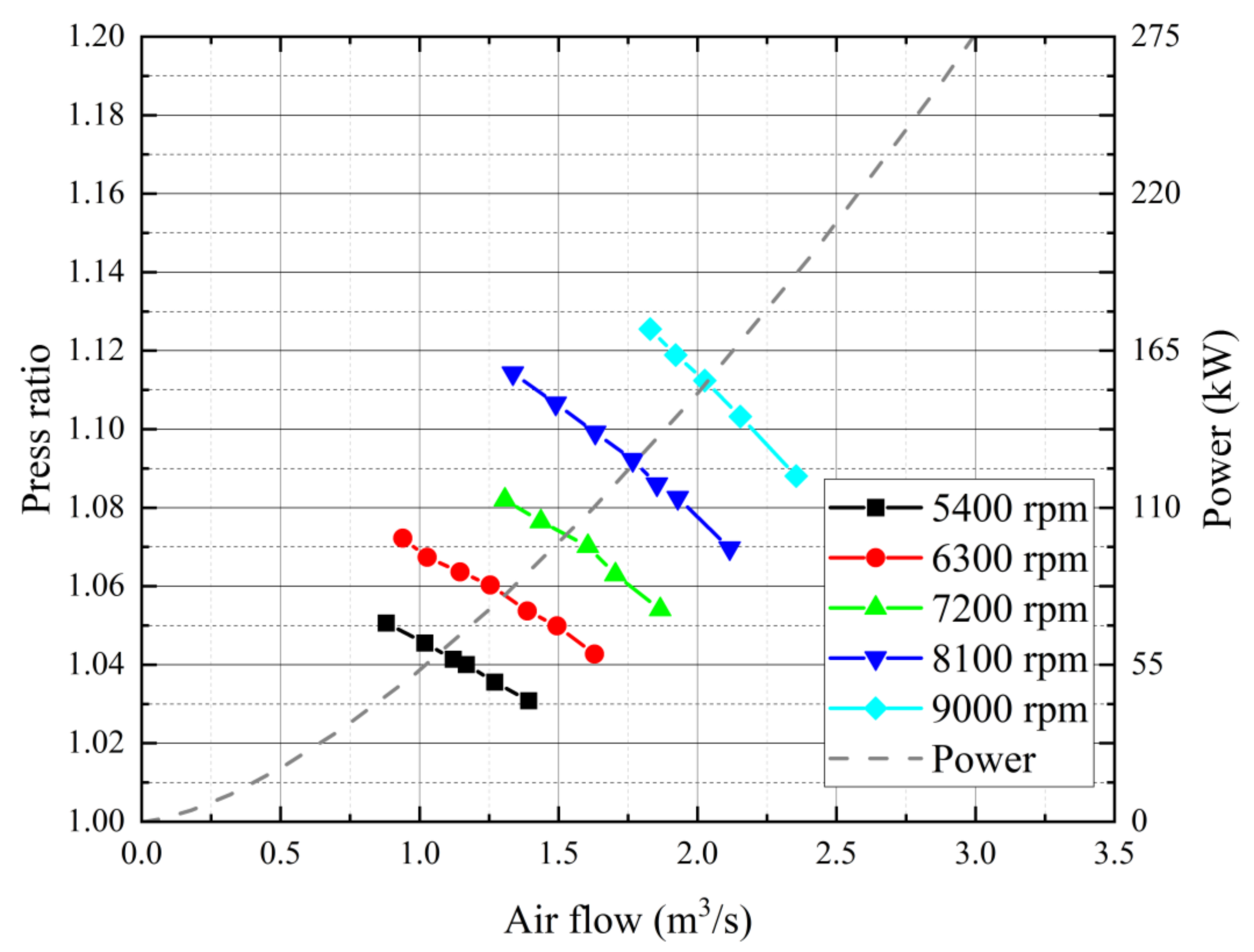
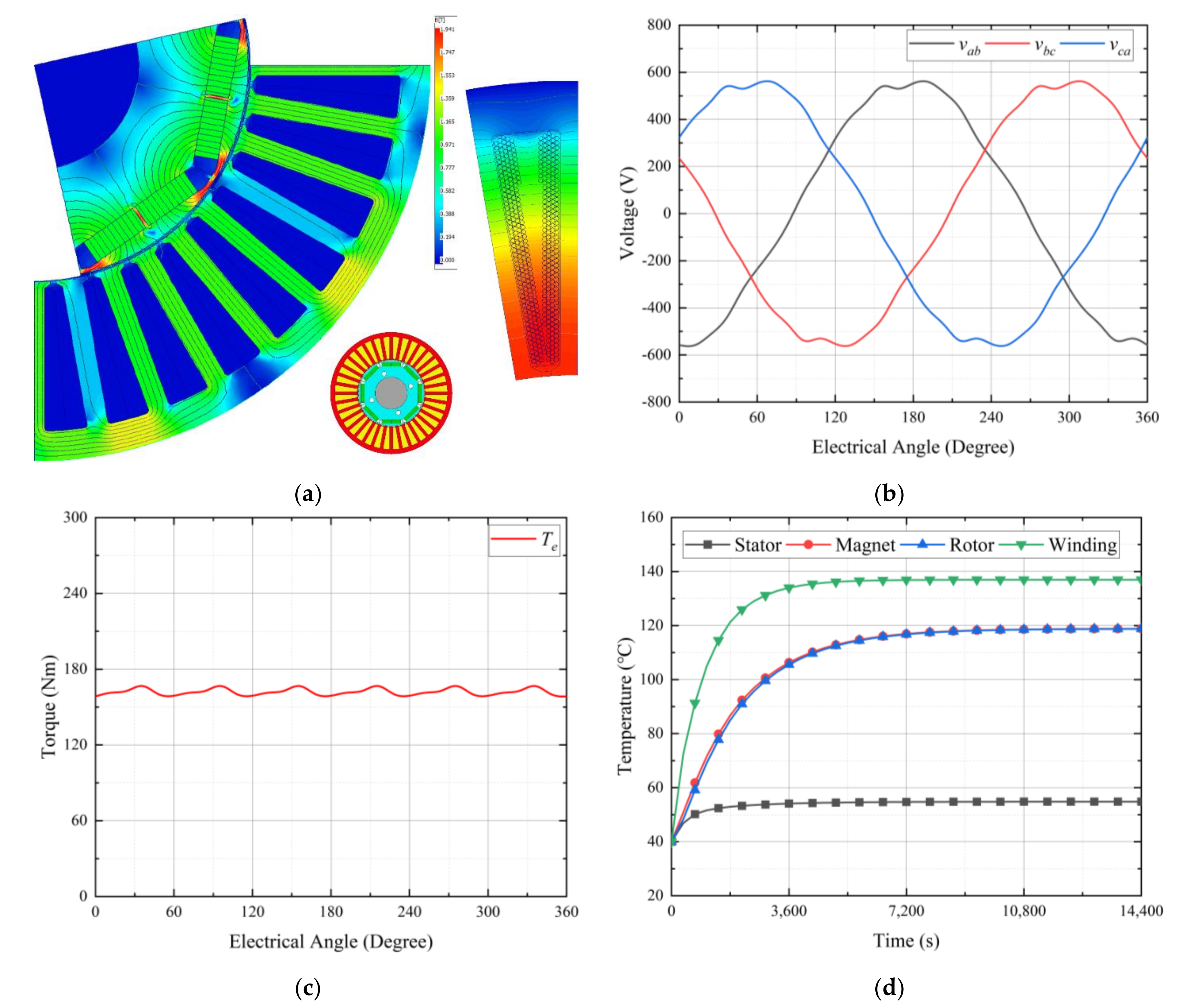
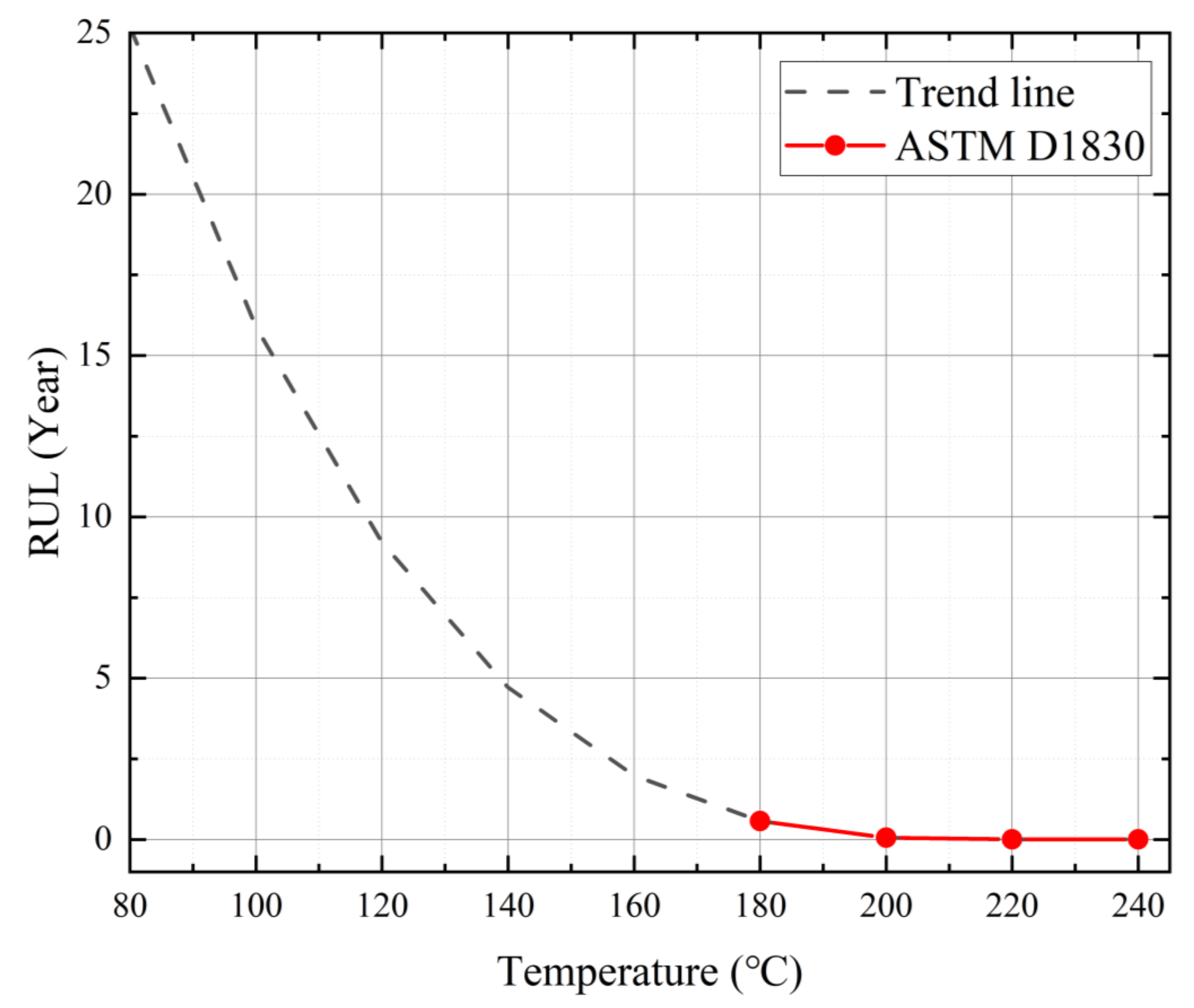
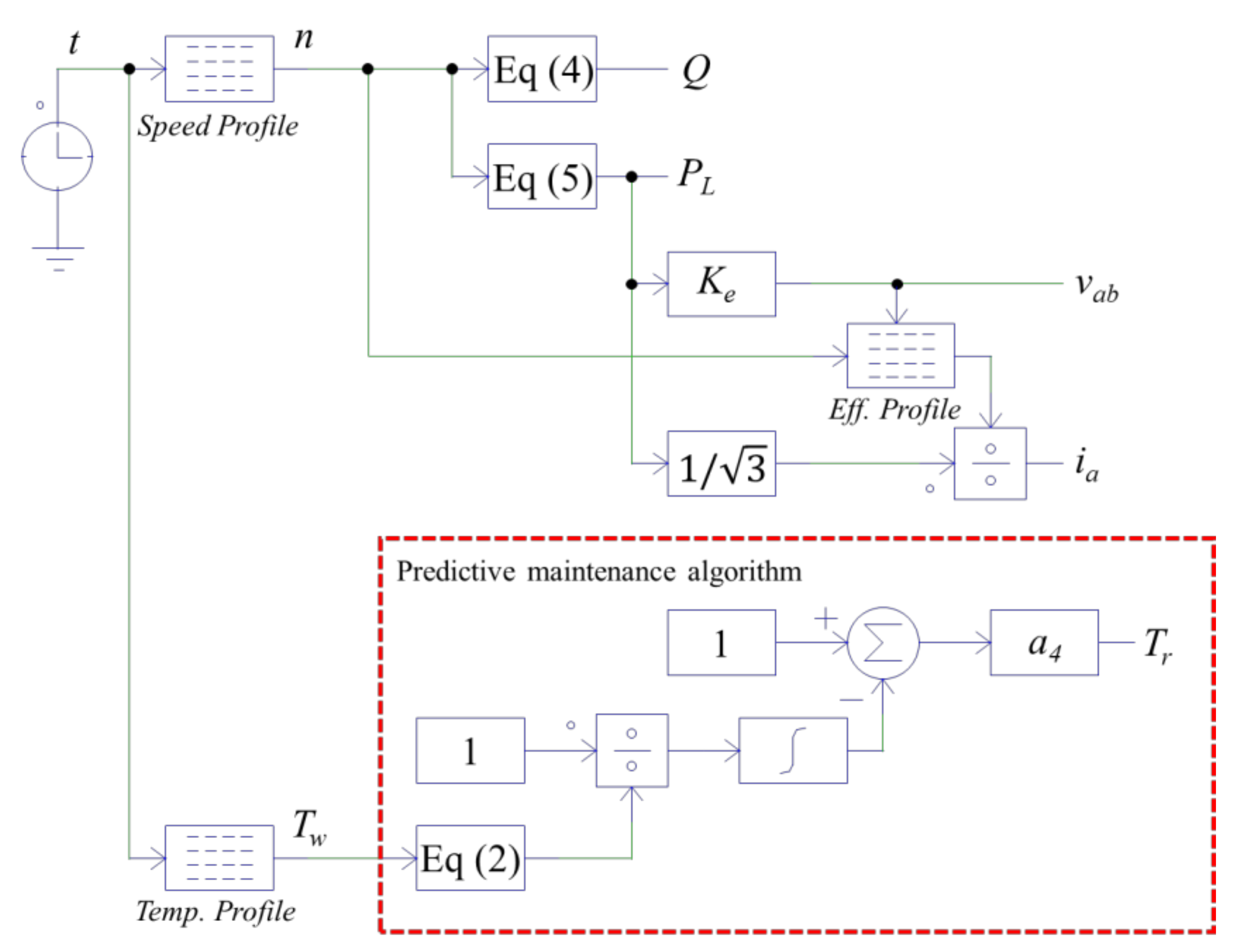
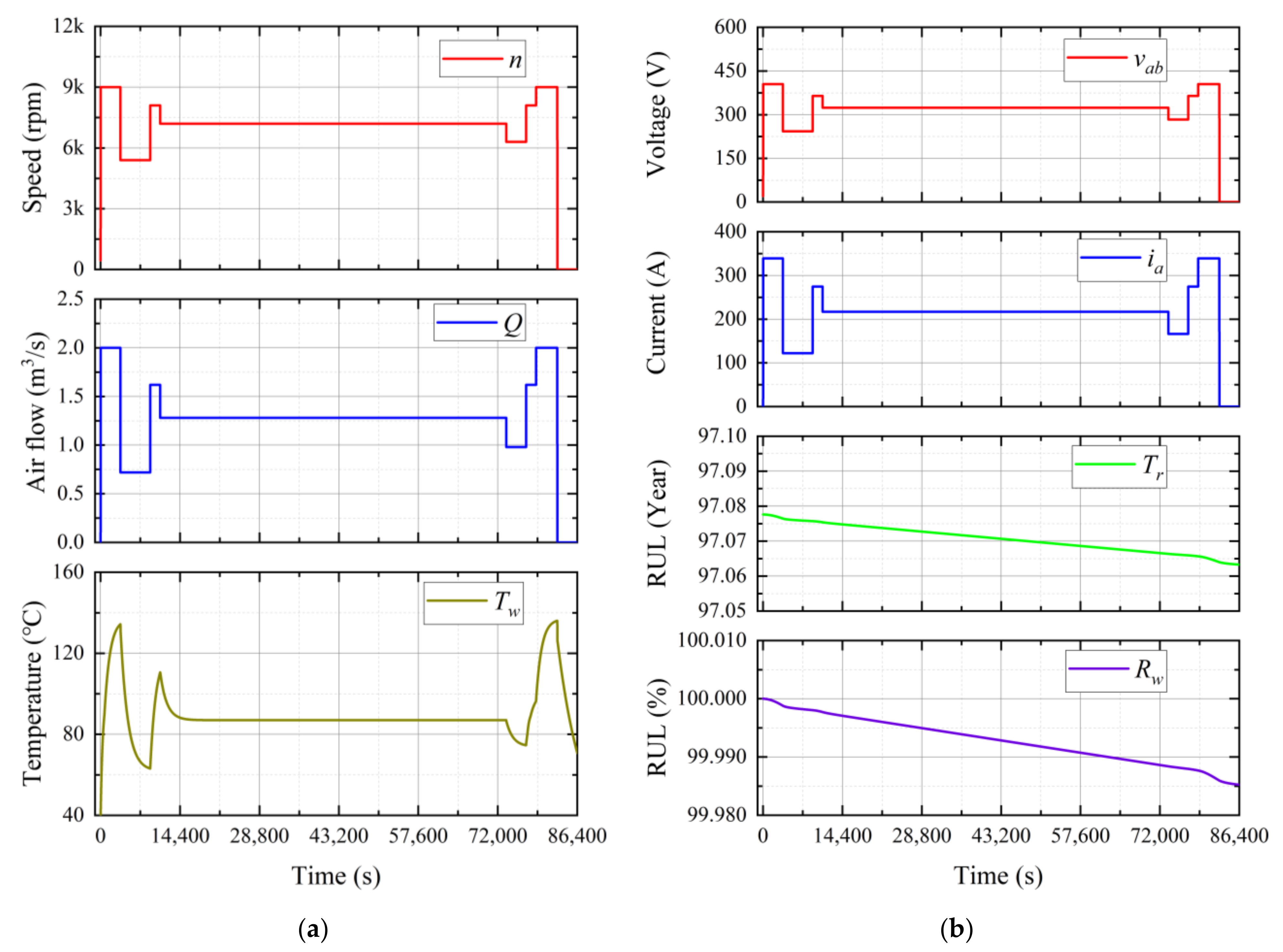
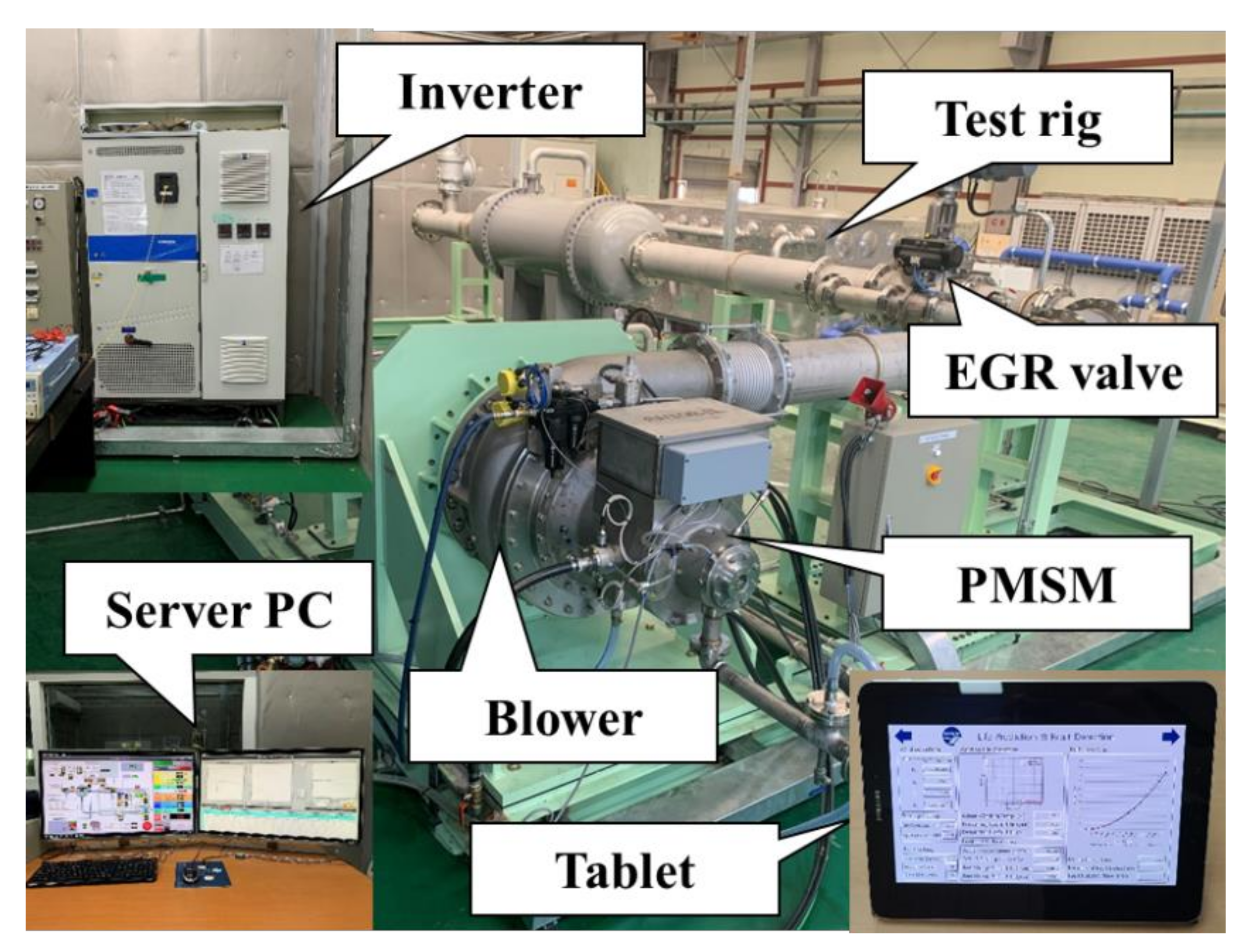
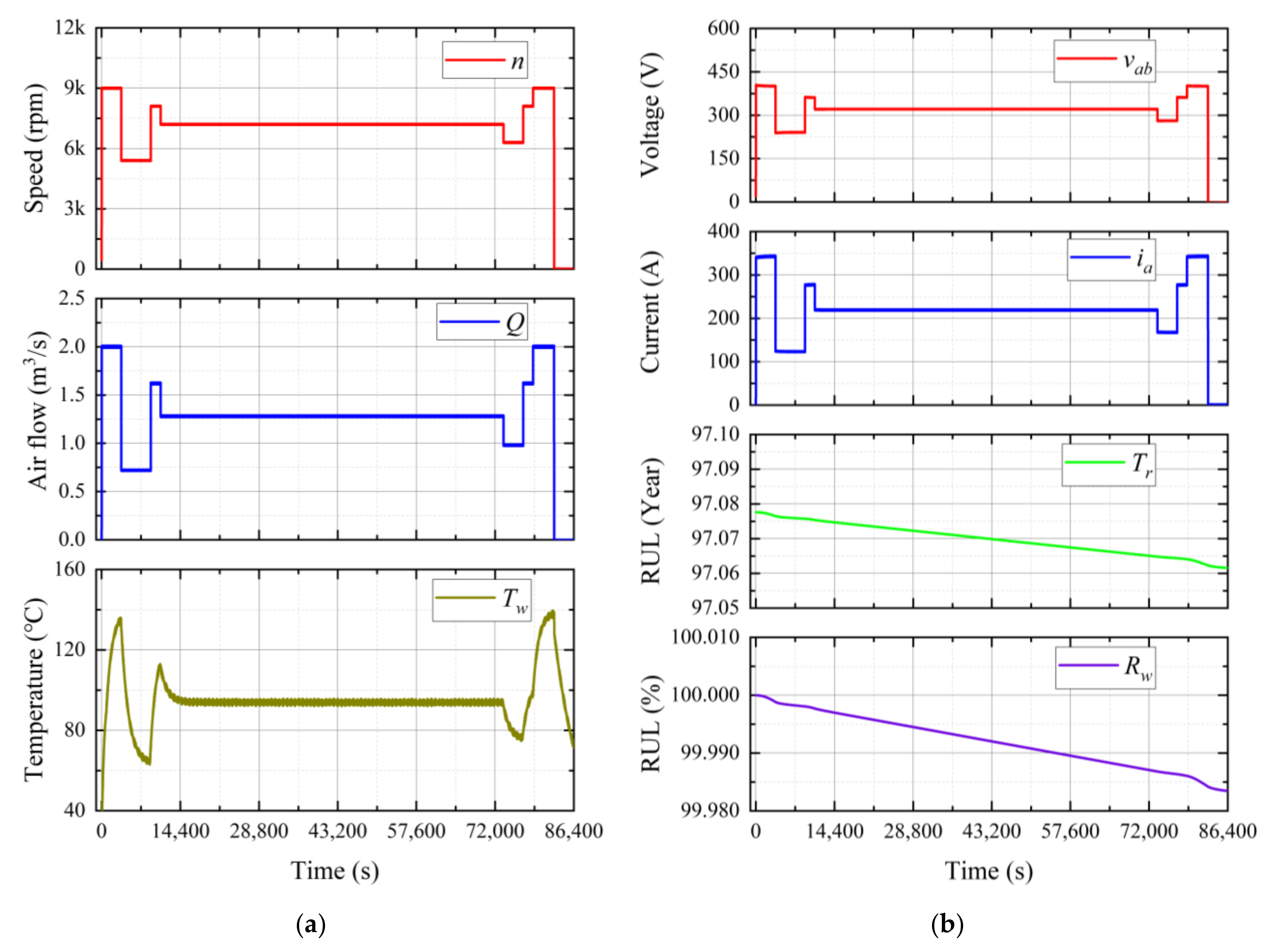
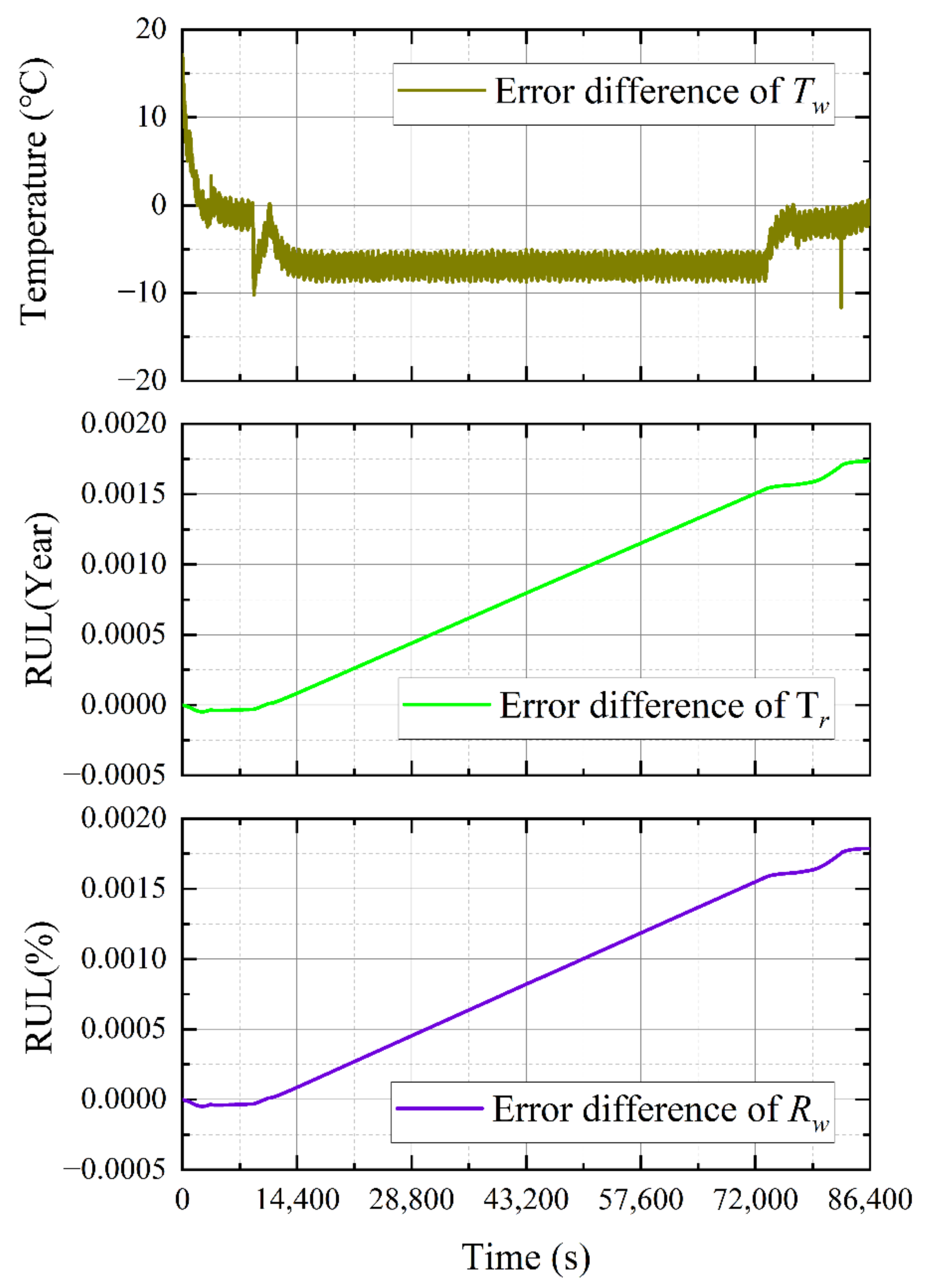
| Item | Value | Item | Value |
|---|---|---|---|
| Rated pressure | 3.5 bar | Motor type | PMSM |
| Rated air flow | 2 m3/s | Input voltage/current | 440 V/340 A |
| Shaft power/torque | 150 kW/159 Nm | Poles/slots | 8/36 |
| Shaft speed | 9000 rpm | Insulation class | F |
| Aging Temperature (°C) | Time (Hours) |
|---|---|
| 240 | 40 |
| 220 | 100 |
| 200 | 500 |
| 180 | 5000 |
| Simulation | Experimental | |
|---|---|---|
| RUL (Year) | 97.0633 | 97.0616 |
| RUL (%) | 99.9852 | 99.9834 |
Publisher’s Note: MDPI stays neutral with regard to jurisdictional claims in published maps and institutional affiliations. |
© 2021 by the author. Licensee MDPI, Basel, Switzerland. This article is an open access article distributed under the terms and conditions of the Creative Commons Attribution (CC BY) license (https://creativecommons.org/licenses/by/4.0/).
Share and Cite
Kim, S.-A. A Study on the Predictive Maintenance Algorithms Considering Load Characteristics of PMSMs to Drive EGR Blowers for Smart Ships. Energies 2021, 14, 5744. https://doi.org/10.3390/en14185744
Kim S-A. A Study on the Predictive Maintenance Algorithms Considering Load Characteristics of PMSMs to Drive EGR Blowers for Smart Ships. Energies. 2021; 14(18):5744. https://doi.org/10.3390/en14185744
Chicago/Turabian StyleKim, Sung-An. 2021. "A Study on the Predictive Maintenance Algorithms Considering Load Characteristics of PMSMs to Drive EGR Blowers for Smart Ships" Energies 14, no. 18: 5744. https://doi.org/10.3390/en14185744
APA StyleKim, S.-A. (2021). A Study on the Predictive Maintenance Algorithms Considering Load Characteristics of PMSMs to Drive EGR Blowers for Smart Ships. Energies, 14(18), 5744. https://doi.org/10.3390/en14185744






